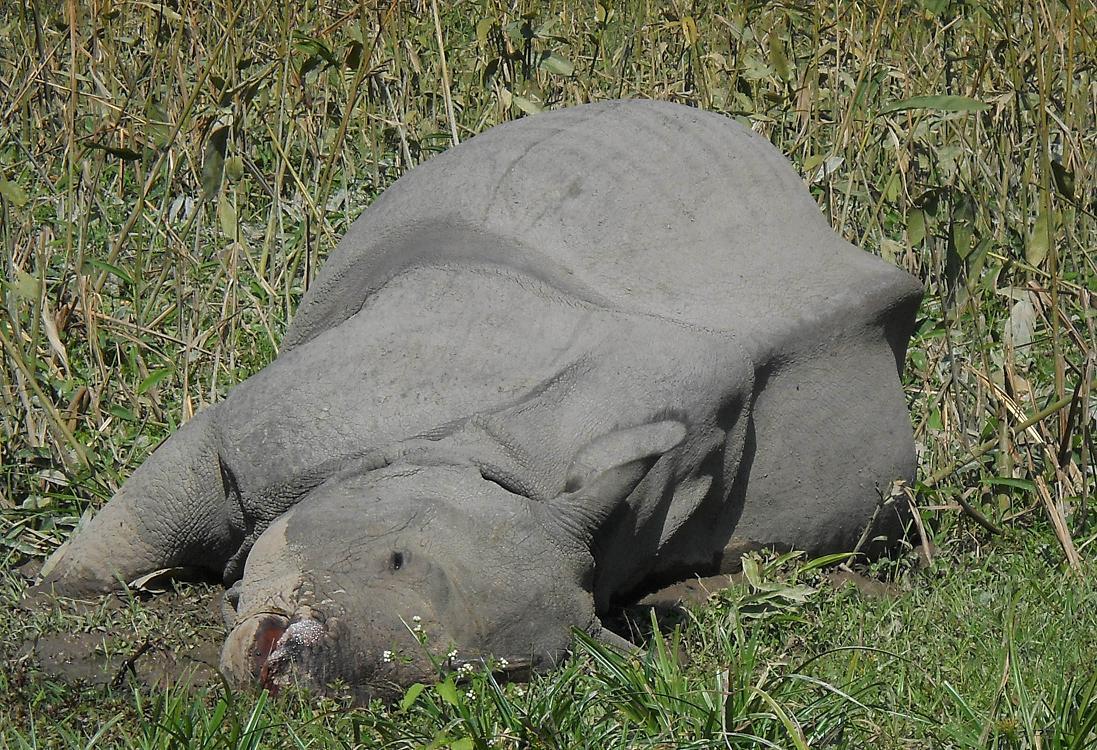The escalation in the incidence of rhino poaching in Assam and the evolving nature of the illegal trade in rhino horn, which threatens to undo conservation efforts and is proving a menace to the survival of the emblem of Assam’s natural heritage. The rhino census 2012 recorded the presence of 2505 rhinos spread across the four protected areas of Kaziranga National Park, Orang, Pobitora and Manas National Park. Official estimates point to a total of 42 rhinos dead in Kaziranga National Park in Assam last year -15 killed by poachers and 27 deaths due to floods. In recent killings, rhino horns were chopped off along with tail and some body parts. The recent poaching incidents have once again brought into focus the vulnerability of an ‘endangered species.’ What was even more perturbing was that in an instance of a recent rhino killing, after the poachers left the mutilated carcass villagers sliced out pounds of flesh from the rhino cadaver.
A spate of successful poaching attempts has revealed loopholes in formulation and actual implementation of policies related to wildlife protection. What accentuates the concern is the possibility of transnational character and dimension of wildlife crimes. The frequency of killings, the extent of violence and the use of sophisticated assault weapons point to organised and well-coordinated operation. The poachers as has been expressed by a senior forest official of Assam could possibly belong to some kind of militia considering the kind of weapon (AK-47 series assault rifle) as evident from the bullets found in the rhino carcass.
 This echoes in the concern expressed by the Prime Minister Dr.Manmohan Singh in September last year about the escalation of illegal trade in animal body parts, animal products and cross-border linkages. This is corroborated in a report by wildlife trade monitoring network TRAFFIC that has identified Vietnam, Thailand and China as countries where the demand for rhino horn for its assumed medicinal value has witnessed resurgence. The killings of a staggering number of 668 rhinos in South Africa in 2012 and its links being traced to smuggling cartels of Vietnam and Thailand is certainly a word of caution to the wildlife crime related intelligence and enforcement agencies. An engaging article in the Independent has linked the spurt in the number of illegal rhino killings to the surge in international rhino horn prices, it comments, ‘the street value of rhino horn is worth more than gold,’ (estimates range from USD $25,000 - $60,000 per kg) and this may as well explain the spate of rhino killed in the sanctuaries in South Africa and smuggled to the East Asian countries, Vietnam and Thailand where there exists a huge market for rhino horn and its various products. Another startling report of a spate of rhino horn robberies last year from museums, auction houses, antique shops and private collectors across Europe- UK, Germany, Belgium, Italy, Czech Republic, Austria and Sweden have set alarm bells ringing.Security agencies were alerted and high security prevails in zoos and national parks. European intelligence suspects the involvement of Irish drug cartel smuggling it across to East Asian markets.
This echoes in the concern expressed by the Prime Minister Dr.Manmohan Singh in September last year about the escalation of illegal trade in animal body parts, animal products and cross-border linkages. This is corroborated in a report by wildlife trade monitoring network TRAFFIC that has identified Vietnam, Thailand and China as countries where the demand for rhino horn for its assumed medicinal value has witnessed resurgence. The killings of a staggering number of 668 rhinos in South Africa in 2012 and its links being traced to smuggling cartels of Vietnam and Thailand is certainly a word of caution to the wildlife crime related intelligence and enforcement agencies. An engaging article in the Independent has linked the spurt in the number of illegal rhino killings to the surge in international rhino horn prices, it comments, ‘the street value of rhino horn is worth more than gold,’ (estimates range from USD $25,000 - $60,000 per kg) and this may as well explain the spate of rhino killed in the sanctuaries in South Africa and smuggled to the East Asian countries, Vietnam and Thailand where there exists a huge market for rhino horn and its various products. Another startling report of a spate of rhino horn robberies last year from museums, auction houses, antique shops and private collectors across Europe- UK, Germany, Belgium, Italy, Czech Republic, Austria and Sweden have set alarm bells ringing.Security agencies were alerted and high security prevails in zoos and national parks. European intelligence suspects the involvement of Irish drug cartel smuggling it across to East Asian markets.
In East and South East Asian societies, rhino horn is endowed with a range of attributes from being a stimulant, medicine as well as prized possession- a status marker. In recent years, use of rhino horn powder as an aphrodisiac has proliferated in the elite circles of Vietnam. Rhino horn powder and its various preparations are regarded as a panacea in most cases-employed in the treatment of ailments ranging from fever to cancer with beliefs of it possessing a possible cure for deadly infections as SARS and HIV.This relates to a revealing report in TIME magazine(June 2011) on the illegal killings of South African rhinos, catering to a demand generated in China by an ambitious state-funded million dollar rhino horn farming project .Promoted by a Chinese conglomerate, which also has arms manufacturing on its business portfolio and boasting of the resurrection of Chinese traditional medicine industry, the TCM (Traditional Chinese Medicine) industry has over the past few years attracted massive Government support and funding. Has this played catalyst in fueling the illegal rhino horn trade market? Conservationists are anxious at reports of horn harvesting experiments underway at farms in the Chinese provinces of Hainan and Yunnan. Wildlife activists are equally concerned at the proposal of "reintroducing wild rhinoceroses from overseas through establishment of breeding centers,’ being undertaken in Chinese rhino farms while looking for ‘wiggle room’ to avoid CITES (Convention on International Trade in Endangered Species of Wild Flora and Fauna) scrutiny. Scientific studies have however ruled out any medicinal value in the horn.
The fact that the South African killings have received widespread international criticism and stringent security arrangements to curb and prevent illegal trade, the possibility of a ‘spillover effect cannot and should not be negated. There is need and reason to be alert and prepared for counteracting a bigger threat than perhaps has been anticipated. An amalgamation of various factors is being cited as facilitating factors-floods, institutional lapses, corruption and the international crime syndicates. It is surprising that floods, which are almost a regular annual feature in Assam, are blamed for the increase in incidence of poaching. The unprepardness of the park authorities every year to tackle the crisis is disquieting. In South Africa, where killing continues unabated, the Department of Environmental Affairs has now resorted to the use of tracker dogs fitted with GPS collars, which are transported to the site of incident by helicopters once a crime is reported to track down the poachers. Another initiative that has been launched is greater use of forensic technology by establishing rhino DNA database banks.
While passionate conservationists question the government over its sincerity in tackling the problem and the state and the central agencies reiterating their commitment to conservation of wild flora and fauna, rhino poaching should concern us all. Discussions for solutions should be in the public domain. The famed one-horned rhinoceros inhabiting the natural landscape of Assam apart from being a major tourist attraction is a testimony to the unparalleled beauty and uniqueness of our natural heritage. It’s time for a movement yet again; the mission-Save Rangmon.






Add new comment